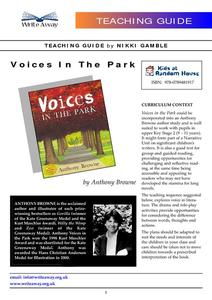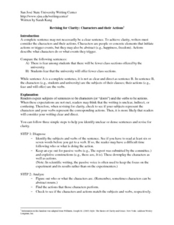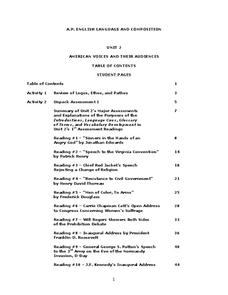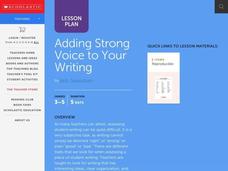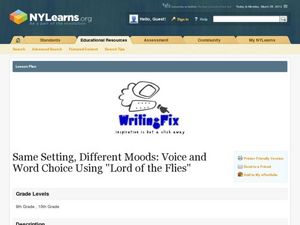Write Away!
Voices In the Park
Explore the impact a narrator's point of view has on a story with a reading of the children's book, Voices in the Park by Anthony Browne. Written in four different voices, the story is told and retold from different perspectives to...
Curated OER
The Passive Voice in Spanish
The passive voice was mastered by Spanish learners. Your class members can find out all about how to create the passive voice in Spanish using ser, past participles, por, and the impersonal se. Examples are provided for each situation.
Curated OER
Grammar-Active and Passive Voice
Use this lesson to reinforce the effect of passive and active voice in writing. First, middle schoolers write several sentences, and then use the attached worksheet to identify whether the sentences are written in active or passive voice.
Curated OER
"Take my Advice": Poems with a Voice
Discuss the meaning of the phrase tone of voice with the class. They respond to a variety of scenarios where a particular tone would be prevalent. They then read "Mother to Son" without knowing the title and answer some questions about...
Schools Linking Network & Lifeworlds Learning
How Do We All Live Together?
Explore the concepts of community and point of view with these activities complementing the children's book Voices in the Park by Anthony Browne. Following a class reading of the story, ask students to either draw a map of the...
Curated OER
Voice and James Joyce
After reading a text written by James Joyce, middle and high schoolers find examples of passive voice. They share their findings with the class. Use this lesson to emphasize the effect of passive voice in writing.
Curated OER
Revision Checklist for the Accordion Essay
Encourage your class to revise their writing and check over their work by requiring them to complete an organization checklist. The checklist, created specifically for a accordion-style essay, asks writers to look over their formatting,...
Maryland Department of Education
The Concept of Diversity in World Literature Lesson 8: Nonfiction Close Reading
As part of their study of Things Fall Apart, class members conduct a close reading of a section of Chinua Achebe's essay, "An Image of Africa: Racism in Conrad's Heart of Darkness." Jigsaw groups then compare the voice in the essay...
Curated OER
Active Voice vs. Passive Voice
What is the passive voice? What is the active voice? Which voice is typically preferred in writing? Use this worksheet to discuss the different voices. Then, have learners rewrite a series of sentences so that they are in the passive...
Curated OER
Active and Passive Voice
Six quick slides show the difference between the active and passive voice and how to eliminate the passive voice in one's writing. Identify the subject and verb of the sentences shown, and rearrange them to change the voice. Encourage...
San José State University
Revising for Clarity: Characters and Their Actions
This handout offers a three-step process for revising sentences for clarity: diagnose, analyze, revise. After reading an example sentence revision with a detailed explanation, learners complete three sample sentences using the three-step...
Northshore School District
American Voices and Their Audiences
Those new to teaching an AP level language and composition prep course and seasoned veterans will find much to treasure in a unit that is designed to help young language scholars develop the skills they need to analyze the language...
Learning to Give
Teaching Playwriting in Schools
The world is a stage, and so is your classroom! Hone the skills of the next generation of Tony® award winners with a set of exercises, reference pages, writing prompts, and excerpts from famous plays.
Curated OER
Adding Strong Voice to Your Writing
Identify examples of strong voice in popular picture books. Young authors add voice to their writing and revise their own writing. In addition, they share their writing with their peers.
National Endowment for the Humanities
Faulkner's As I Lay Dying: Burying Addie's Voice
High schoolers explore the use of voice and title in William Faulkner's, "As I Lay Dying". They identify and discuss the use of image, symbols and narrative voice in the story.
Curated OER
The Passive Voice in Questions
In this recognizing the active and passive voice worksheet, students read interrogative sentences in the active voice and rewrite them in the passive voice. Students write 12 answers.
Curated OER
Active Voice vs. Passive Voice
Can your class tell the difference between passive and active writing? Use this lesson in your writing conventions unit. The lesson prompts middle schoolers to create essays, demonstrating understanding of an active versus passive voice...
Curated OER
Sentence Starters - The Passive Voice
Discuss the active and passive voices with this packet. There are several exercises to complete! First, identify which sentences are active and which are passive. Then, create sentences in the passive voice with the given topic. Finally,...
Curated OER
Borrowing Narrative Skills from Mr. Fletcher: Using a "Prompts in Reverse" Technique to Inspire Your Writers
Help your class find their writing voices with this instructional activity which uses the work of Ralph Fletcher to guide a "Prompt in Reverse" activity. Using the chapter "First Pen" from Fletcher's Marshfield Dreams, learners decipher...
Curated OER
Character Attributes in Writing
Third graders analyze the importance of characters in fiction writing and performances. For this theatre lesson, 3rd graders identify the important characteristics of a fictional character and how to portray a character through many...
National Endowment for the Humanities
Poems that Tell a Story: Narrative and Persona in the Poetry of Robert Frost
Dig in deeper with Robert Frost's, "Stopping by Woods on a Snowy Evening." Learners will read and discuss poems by Robert Frost and learn the meaning of terms such as narrative and personal. They journal, collaborate, and present poetry...
Curated OER
Write On!
Help empower your class by learning about the editorial section of the newspaper. They will have the option to also write to a politician. The goal is to teach students how to speak-up and express their opinions on important issues....
Curated OER
Same Setting, Different Moods: Voice and Word Choice Using Lord of the Flies
Whether it's dark, delightful, or somber, set the mood with William Golding's Lord of the Flies. High-schoolers practice descriptive writing by creating the appropriate mood for an original scene, starring one of the book's main characters.
Voices of a People's History
Voices in The Classroom
Everyone's perspective of the past is different. A thought-provoking unit gives young academics the opportunity to explore their perspectives on history and their neighborhoods. Based on the work of Howard Zinn, each lesson explores...
Other popular searches
- Teaching Voice in Writing
- Using Voice in Writing
- Creating Voice in Writing
- Express Voice in Writing
- Put Voice in Writing
- Personal Voice in Writing
- Defining Voice in Writing
- Recognizing Voice in Writing


